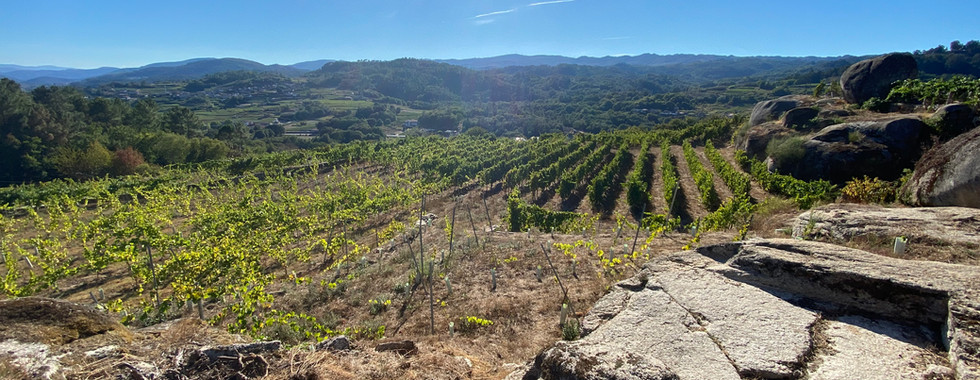Antonio Miguez Amil brings back to life the historical wines of Ribeiro
- Miguel Crunia

- Sep 26, 2022
- 6 min read
Updated: Oct 10, 2023
Talking about Antonio Míguez Amil is talking about an "adegueiro" (vigneron in the local Galician language) who is obsessed with the idea o bringing the old and reputed wines of Ribeiro back to life.
Ribeiro is a complex reality, probably one of the oldest and most reputed regions in the old world, mostly forgotten nowadays that in the past stood on its own. We must go back to the 8th century until the 18th century to witness Ribeiro's Golden Ages, when a barrel of wine from this area cost 2 or 3 times more than a barrel from Burgundy or Bordeaux.
Simplistically divided into 3 valleys cut by 3 rivers (The Avia, the Miño, and the Arnoia) the reality is that the Ribeiro is far more complex than that as it is cut by more than 20 rivers which create small sub-regions with very diverse micro-climates. Is in the Avia Valley (specifically in the area of Cenlle) where we find Antonio's Boas Vides (Good Vines). His goal is to preserve the essence and identity of the red wines that come from the old slopes of the Avia valley; wines in which their origin is respected, that of old varieties that have almost disappeared.
Antonio's story is that of a man who started a little late in viticulture, despite having grown up in it. His grandfather was a "colleiteiro" (aka vinegrower) who pushed his children to look for a future away from the countryside back in the '70s. It was an uncle of his the one who taught Antonio how to take care of the vineyard and, at the age of 25, he was left with the abandoned vineyards of his grandparents, which were of not much relevance. That is why he sold them and began looking for vineyards located in historical sites within the Avia Valley (which was once the Galician Burgundy) filled with "socalcos" (terraces) and natural slopes. He bought many of the small parcels that today make up his vineyards little by little (because minifundia forced him to make deals with many small land owners) to finally unite them into what today are his single vineyards.
His philosophy not only agrees with the postulates of Steiner but also pays attention to the words of Galician writers who captured winemaking traditions in their texts, such as Castelao, Manuel María, Otero Pedrayo, Fina Casalderrey, Curros Enrriquez or Marina Mayoral among others. The curiosity to find out everything he can about that lost knowledge of previous generations is what leads him towards recovering the old taste of the wines that once made Ribeiro shine in the whole world.
Antonio is without a doubt a very interesting character. A man to visit without haste since he is probably the most important walking encyclopedia that you can come across in the Ribeiro. We visited him at the beginning of September when many were already harvesting, he was remaining observant with the calm of one who waits for the rain to recover some water to achieve a proper phenolic ripeness rather than harvesting prompt grapes given by dehydration.
Soon we jumped into his car and headed to set foot in 2 of the vineyards that he recovered: San Lourenzo and Peitieiros; both historically owned by farmers who provided their grapes to the S. Clodio monastery.
San Lourenzo is a breathtaking vineyard located at 265m of altitude with its terraces breaking down a vertiginously inclined hill (35%). This vineyard is broken down in two by the rural road that took us here. On the left side of the road, we have a beautiful terrace, one of those that leaves you speechless contemplating it without saying a word for minutes. Mostly planted with Carabuñeira (aka Touriga Nacional), but there are also some Zamarrica (also known as Caíño da Terra), Caíño Longo, some Espadeiro, and quite a bit of Brancellao.
This vineyard is witnessed by a medieval cellar that was operative until the 60s when it was destroyed by a wildfire and, since then, it has never been restored. At the foot of this old stony cellar is where his white "castes" (varieties) are planted: Verdello Antigua, Albilla do Avia, and Lado. The plot on the right side of the road, the one with the highest altitude, has an old vineyard that is over 65 years old, planted with Garnacha and Sousón vines. They are wild vines, planted without any type of conduction system; pure bush vines. He complemented it with new plantings of Brancellao, Verdelho Antigo, and Moscatel de Grao Miudo.
Peitieiros, on the other hand, is a vineyard located at a lower altitude, 180m, and it is charged with great viticultural energy since here we find the remains of a lithic cellar that dates all the way back to the 6th century. Here Antonio is recovering Brancellao and Espadeiro as red varieties, and Verdelho Antigo, Lado, Albariño, Treixadura, and Blanco Lexítimo as whites.
2022 is proving to be a challenging year in every way, as to the challenge of facing one of the driest vintages in history, he also needs to finish his new winery (in the heart of Ribadavia) in time to vinify this upcoming harvest, because he was sharing cellar with his friend Iago Garrido until now; which is where we headed to taste his wines.
Inside the winery, Antonio's philosophy is clear: His wines are field blends, where each variety is vinified separately, allowing them to get the best of themselves thanks to achieving complete macerations. All his reds spend a minimum of 6 months in old barrels before coming back to rest in stainless steel tanks prior to being bottled, where they would rest even longer until he decides to release them to the market. Sulfur levels are below the level recommended by Demeter.
Boas Vides 2019 will soon arrive in our portfolio and we can tell you in advance that it has been a fresher vintage than 2018, filling the wine with great finesse. Portuguese-like nose with a very expressive concentration of red fruits, lots of bay leaves, pine, and eucalyptus. On the palate, it is dynamic, silky, and with an enviable freshness. Even if it has great drinkability right now, we would recommend stocking some extra because its cellaring potential is astonishing!
This new vintage also brings us an important change in the design of the label since Antonio wanted a less formal image, but one that would reflect that he has such healthy and flavorsome grapes that wild animals (wasps, birds, wild boars, and foxes) always devour a good part of his crop.
The most exciting part was being able to taste, straight from the barrels, tanks, and unlabelled bottles, some of the most personal projects he is working on. We leave you with a preview of our impressions:
- 2021 was the 1st vintage of a white wine that is still evolving in a stainless steel tank. Here, he is rediscovering one of the indigenous varieties in the Ribeiro: the Verdelho Antigo; which he blends with a bit of Treixadura and Lado. A wine that has also stayed 3 months in barrel beforehand, where malolactic took place. It's super aromatic, you wouldn't call for Galicia on the nose if tasted blind. Loads of flowers, banana skin, wild peaches, varnish, and kerosene. It's textural, flavorsome, and with very well-integrated acidity. Surprising and unique.
- Boas Vides '20 & '21: These are wines that are very defined by the nature of each vintage, '20 being a wine with warmth and remarkable finesse; and the '21 showing up sharper and brighter. They're not ready yet, but watch out because '20 is going to give a lot to talk about.
- Mirando ao chao '19 (Brancellao & Caíño Longo): "Looking at the ground" is a label that bottles a wine that has spent a whole year buried underground to give it time to age without noise, without light, and without temperature variations (thanks to the granitic soils), just as some ancestors used to do in this area. Prior to that, the wine was aged for about 6 months in oak barrels. It's superb, opening up with gunpowder, herbaceousness, leather, blood, iron, and loads of flowers. A bit rustic but also with great dark fruit. Wide, silky, greedy, balanced, spiced, vital, and long.
- Para do Pé is a "Tostado do Ribeiro"; meaning a wine subjected to a previous process of drying the grapes, concentrating sugars, and obtaining a naturally sweet wine in return. A style of production that is similar to that used to produce Recioto Della Valpolicella, but that is not uncommon in this region, since Tostado del Ribeiro was a low-production wine (Antonio produces only approximately 300 bottles a year) that was reserved to pay favors.
Without a doubt, Antonio's project is unique, exciting, emotional, and full of passion; that tries to recover the lost character of the wines that, in their day, were the most valued in Europe.
Miguel Crunia
Director at Fìon
info@fionwines.co.uk





























































Comments